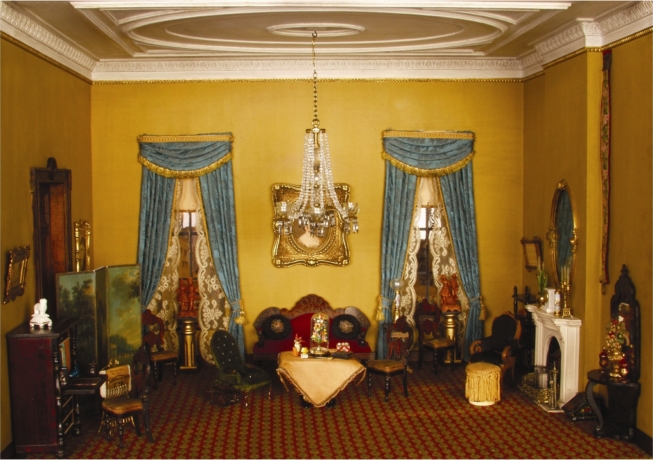
Exhibitions
THE THORNE ROOMS
Knoxville Museum of Art / 1050 World's Fair Park Dr. January 1, 2010 - December 31, 2036
The Thorne Rooms were developed in the 1930s and 40s by Mrs. James Ward Thorne, Chicago, IL, who loved dollhouses as a child. After extensive travels in Europe where she collected miniature furniture and accessories, Mrs. Thorne had over two dozen miniature rooms created by cabinetmakers from her own drawings. They were made in a scale of one inch to one foot. She painted and stained woodwork, papered walls, and made textiles for the rooms.
The rooms were displayed in several World’s Fairs. In 1933–1934 they were displayed at Chicago’s Century of Progress Exposition. In 1939, they traveled to San Francisco’s Golden Gate International Exposition, and in 1940 they were displayed at the New York World’s Fair.
Later, Mrs. Thorne created 29 more rooms, copying Europe’s castles, museums, and historic homes. She commissioned architects to create historically accurate settings and had textiles and carpets made by the Needlework Guild of Chicago. The rooms, tracing English and French style 1500–1920, were exhibited in 1937 at the Art Institute of Chicago. In 1942, Mrs. Thorne gave a third and final group of Thorne Rooms to the Art Institute. Those 37 rooms offered a view of American History, 1675–1940.
In 1962, IBM, which had purchased 29 rooms, gave nine of the original Thorne Rooms to Knoxville’s Dulin Gallery of Art, this museum’s predecessor. Our rooms contain many of the miniature objects Mrs. Thorne collected during her youth and on her travels. The Knoxville Museum of Art is one of five museums in the country to have a collection of Thorne Rooms.
KMA’s Thorne Rooms are historically important not only as vivid records of period settings, but also as some of Thorne’s earliest works.
About Knoxville Museum of Art:
The Knoxville Museum of Art began its institutional life in 1961, establishing core values as a community-rooted organization that mined what art and culture could mean in East Tennessee. In the late 1980s, operations moved to a downtown location to serve a growing community. The modern-day KMA opened in 1990 in a 53,200 square-foot facility designed by architect Edward Larrabee Barnes. By the new millennium, the Museum’s collecting and programming mandate also advanced from an array of traveling blockbusters and local craft to focus on an archaeology of the fertile history of Appalachia and its evolving present. Our core exhibition project, Higher Ground: A Century of the Visual Arts in East Tennessee, was decades in the making, proposing a more inclusive historical narrative that entrenches the importance of stalwarts such as Lloyd Branson, Catherine Wiley, and the Knoxville Seven, while also recognizing the contributions of previously marginalized artists, most notably brothers Beauford and Joseph Delaney, as well as the self-taught Bessie Harvey. The KMA enters its next organizational chapter by way of a programmatic vision that pushes our purview into a more expansive geography. Under the banner of Appalachian Imaginary, the Museum presents a dynamic series of exhibitions that embrace a wider lens with which to see our site, and ourselves. Located at 1050 World’s Fair Park Drive in downtown Knoxville, the museum is open Tuesday through Saturday (10:00 AM–5:00 PM) and Sunday (1:00–5:00 PM). Admission and parking are free. Learn more at knoxart.org.
Press Contact: Sarah Kaplan, skaplan@knoxart.org, 865-934-2034

